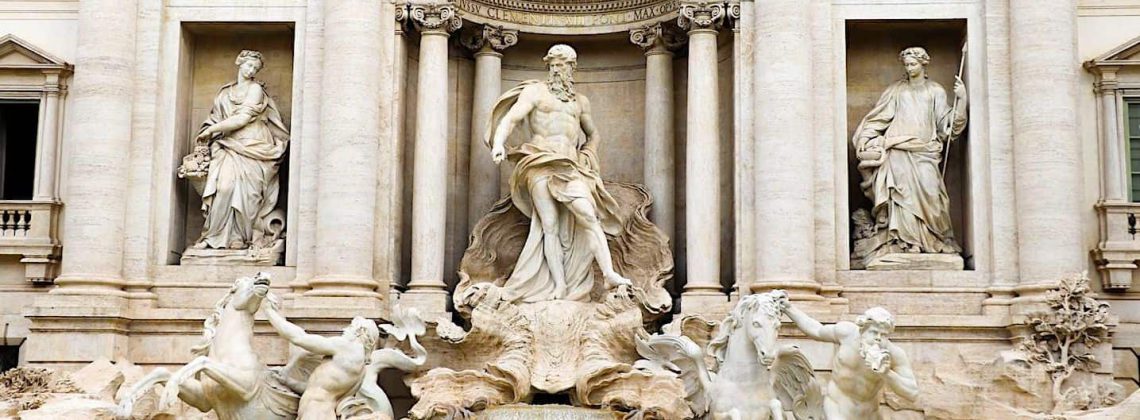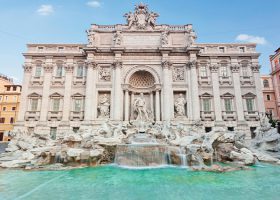The Trevi Fountain is probably the most famous fountain in the world. It also happens to be situated in one of our favorite cities, Rome. We love it not only for its aesthetic beauty but also for the stories behind it. But how much do you really know about the Trevi Fountain and how about some cool Trevi Fountain facts?
Brandon’s Pro Tip: I like to bookmark helpful posts in a folder so I can circle back prior to or during my trip. So if you are planning on traveling to Rome at some point, bookmark this article and enjoy!
16 Astounding Facts About The Trevi Fountain
The Trevi Fountain is a baroque icon that averages between 1000 to 1200 visitors per hour in a normal year. It is easy to snap a pic, throw your coins in the fountain and go but you found this article which means you are a savvy traveler that wants more.
Get ready to learn some cool facts about this fountain that continues to fascinate us over time and has become a necessary stop on everyone’s agenda who visits the Eternal City.
16. That Statue in the middle is not Neptune!
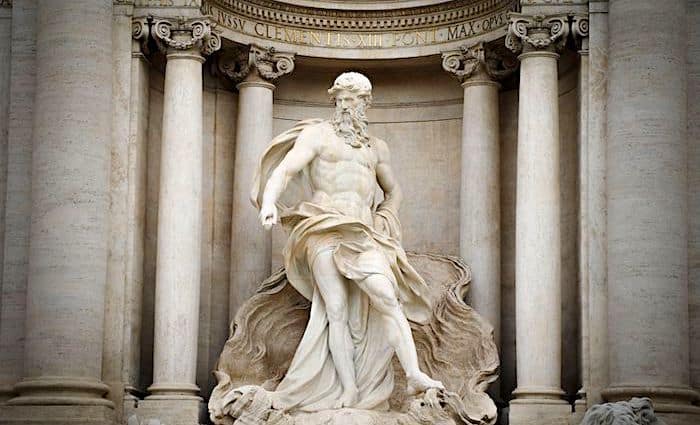
In the center of the fountain, you’ll find Oceanus, who was a Titan and the god of the sea. Titan gods were a generation of gods that came before many of the pagan gods famous today such as Zeus (Jupiter) or Apollo. There is a pretty complicated backstory behind the Titans but what is important is that he is the main statue on the front of the Trevi Fountain and he controls the sea.
He rides a shell, like any good god of the sea, which is pulled by two Tritons (think Mer-man from Zoolander). Don’t confuse him with Neptune. Gods are easily identifiable by whoever is around them (think posse). While Oceanus is accompanied by two Tritons, Neptune would have a trident and a dolphin in tow.
The Triton to Oceanus’ right (our left) represents the harshness or roughness of the sea. To his left (our right) you can see the calmness and tranquility of the sea.
15. The Architect Lost the Competition, but Built it Anyway
In 1730, Pope Clement XII organized a contest to build a fountain at the terminus point. Remember that in the 18th century, Rome was at its peak of Baroque art, so everything had to be monumental and grand- think Spanish steps.
The competition was actually won by a Florentine, but due to the angry Romans demanding a Roman build it, the Pope relented and gave it to Nicola Salvi. The fountain was finished in 1751 after Salvi’s death.
14. There are friezes telling the story of how it was found
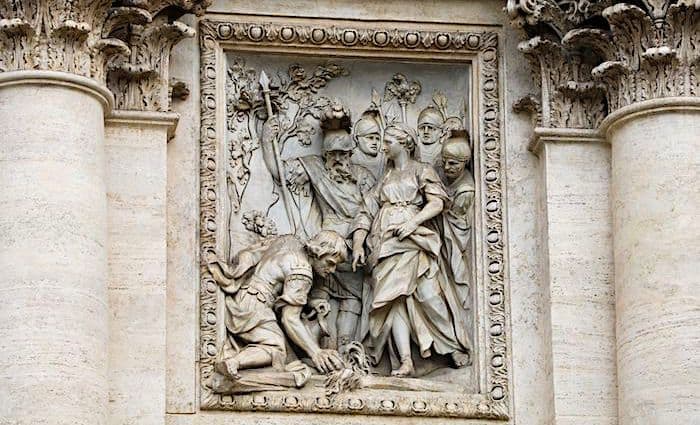
Apparently, Marcus Agrippa was returning from a long battle on a hot summer day and his troops were dying of dehydration. They were in search of water but none was to be found!
A young girl (virgo in latin) appeared and showed them a source from where they could get fresh water. This new water revitalized the army and they returned to Rome. M. Agrippa went back looking for the young girl, but she was gone. He decided to build an aqueduct from the source that fed into Rome.
You can see this scene depicted in a relief sculpture located above Oceanus (centerpiece) to the right.
13. It is All in The Name
One of the more obvious facts about the Trevi Fountain is the name. The word “Trevi” refers to the small piazza it sits in and the three roads that meet in that piazza. The number three in Italian is “tre” and road/street is “via”. Tre-via or Trevi. Fontana di Trevi or fountain of three roads.
12. It is Connected to a Museum Nobody Goes To
One of the more strange facts about the Trevi Fountain- but very true. The building is called Palazzo Poli. Palazzo Poli is a museum that houses engravings and other important artifacts.
11. Very Popular in Making Movies

By now you understand that the fountain is pretty famous. A further testament to that are the films that involve the fountain.
The main ones you might have heard of are Roman Holidays ( 1953), 3 Coins in the fountain ( 1954), and La Dolce Vita ( 1960), with the last one featuring the famous scene of Anita Ekburg seductively wading through the fountain. These films catapulted the fountain onto the international stage.
10. The Material Used is the Same as for the Colosseum
The stone is called Travertine and comes from the small town of Tivoli, which is about 20 miles away from Rome. The stone is a porous limestone which is not good for making sculptures but is great for buildings ( and countertops).
9. All of the Money Collected from the Fountain Goes to Charity
One of. the most heartwarming facts about the trevi fountain are where all that money goes. I am very sure that you may have heard a different story but the end result is 3000€ +/- going into this fountain each day. Prior to the euro, this number was undoubtedly less but travelers may find themselves throwing 1€ and 2€ coins in unknowingly.
One throw could earn the fountain 6 € and if you stop by the fountain during high season people are throwing coins in non-stop. Every night the money is collected and sent to the charity Caritas.
8. The Artist had the Last Word
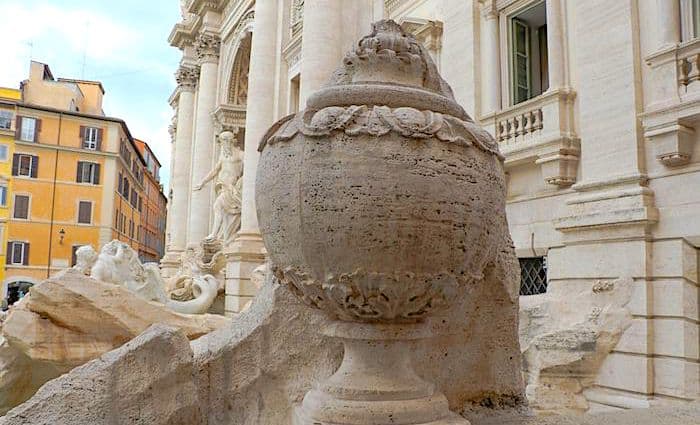
One of the funniest facts about the Trevi Fountain is an anecdote. Apparently, when Nicola Salvi was building the fountain, there was a barbershop and a barber within the shop. The barber was not very happy about the construction of the fountain. The barber was short-sighted and didn’t like how the fountain was hurting his business and so he gave Salvi a lot of trouble. It must have been enough trouble to really piss Salvi off.
Salvi was a Baroque artist and Baroque artists love hidden stories and meaning. Creating beautiful works of art is just the first step for guys like Salvi. So, to add to the dimensions of the fountain, he built a vase resembling the Ace of Cups or Asso di Coppe from the Sicilian card game Scopa. The game has complexities, but winning is defined by a final moment where a player throws the final card down and wins.
When Salvi built the Asso di Coppe he built it so that it blocked the Barbershop from the view of anyone standing in front of the fountain – which drew huge crowds similar to today. I imagine when the Barber saw the completed fountain and realized what Salvi did, he felt like someone had just thrown down the Ace of Cups and cleared all the cards off the table.
The barber had been beaten.
7. If you Jump in, You will Be Fined
Remember not to jump in the fountain! The local police will definitely catch you and will slap you with a 500€ fine! While you might see some people in the summertime try and go for a swim, the police act fast. I actually know someone who did jump in and yes, they were caught. And yes they had to pay a 500€ fine!
6. The Truth about How Many Coins to Throw in
In Italian they call it “il lancio della monetina.” Basically you throw different numbers of coins in the fountain hoping for varied results.
1 coin grants you a safe return to Rome.
2 coins grant you a safe return to Rome and you’ll fall in love.
3 coins grant you a safe return to Rome, fall in love, and get married.
5. You Can See the Aquaduct Still
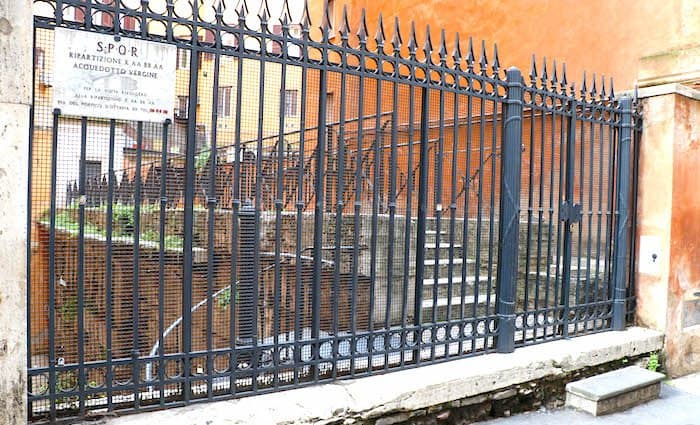
The aquaduct that feeds the fountain is called the Aqua Virgo. As mentioned above it was built over 2,000 years ago. While there have been many renovations over the centuries, the original tunnels are still functioning today.
To see a good piece of the aqueduct, you need to walk about 7 minutes from the actual fountain. You will find a small alley behind a restaurant and a small gap between buildings with a big fence. Lo and Behold you will witness two huge arches with a trough on top where the water gets piped into even today!
Address: Via del Nazareno, 9a
4. The Fountain pumps Out Over 10 Million Liters of water per day
According to Turismo.it, the fountain spills out of its beautiful sculpture 170 liters per second. By doing the math, you understand how much that is in 24 hours. That is almost 3 million gallons of water per day! The water is recycled so it doesn’t go to waste.
3. 2,000 Years and Still Running Strong
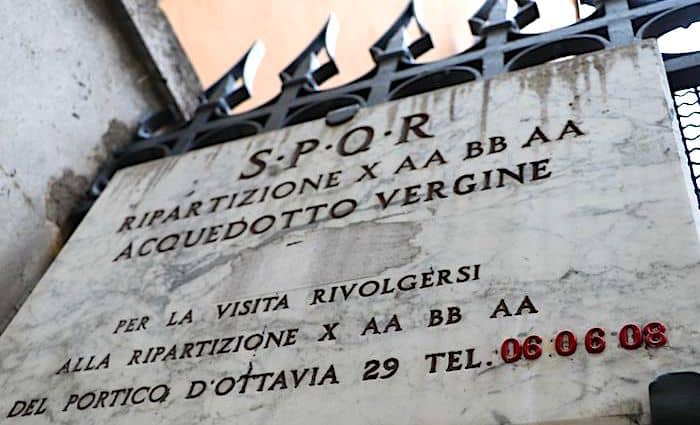
As mentioned above, the aqueduct called Acqua Virgo was built 2,000 years ago. And while various renovations have taken place, the water that feeds this fountain is the same that has been feeding it for more than 2,000 years. Therefore if you were to drink out of the fountain, you would be drinking the same water that Ancient Romans were drinking. How cool is that!
Actually, you are not allowed to drink from the fountain itself, but there is another solution! The Acqua Virgo not only feeds the Trevi Fountain, but also all the surrounding fountains. So what are you waiting for? When you see a drinking fountain close to the Trevi, try a sip and relive history!
2. The Fountain was paid for by Gambling
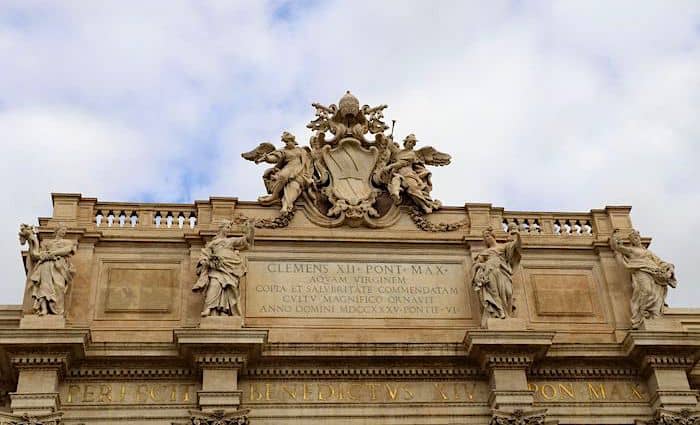
Back at the time of construction, Rome was ruled by the Popes. The particular pope who commissioned Salvi to build the Trevi Fountain was Pope Clement XII ( Pontiff 1730-1740).
As you can imagine, there were lots of bills to pay, so when Salvi was commissioned to build the fountain, the pope needed to get money from somewhere, so he reinstated the Lottery. A certain amount of proceeds from the lotto were used to pay for the fountain. Who would have thought?
Popular Vatican Tours

Best Selling Tour
Privileged Entrance Vatican Tour with Sistine Chapel
Without the right access, visiting the Vatican means fighting crowds, long waits, and missing the most significant rooms and works of art. Our privileged entrance tour offers more than just entry—it’s an immersive experience led by a storytelling guide who brings the Vatican to life. Skip the line and explore the Vatican Museums, including the Raphael Rooms, the Sistine Chapel, and St. Peter’s Basilica with engaging insights that make each moment memorable and meaningful.
See Prices
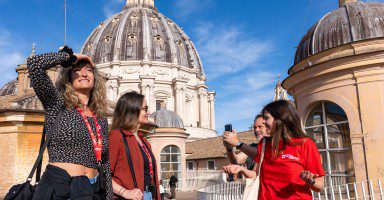
Top Rated Tour
Ultimate St. Peter’s Basilica Dome Climb and Tour with Papal Tombs
Visiting St. Peter’s Basilica and its dome on your own can mean dealing with crowds and waiting in line for hours. Our early-morning tour, led by a captivating local guide, ensures you skip the hassle with privileged access and insider knowledge, including the best times to climb for awe-inspiring views. Explore the stunning Basilica, take in breathtaking panoramas, and descend into the sacred Papal Crypts for a truly immersive experience.
See Prices
1. An Actor was drunk while Filming in the Trevi Fountain
The most famous scene in the film La Dolce Vita is when Mastroianni and Anita Ekburg go into the Trevi fountain. It is a compelling scene, but they filmed it in March when it was still pretty cold outside. According to director Federico Fellini, Anita Ekburg said that she could stay in the water for hours without a problem. Marcello on the other hand was so cold, he had to put a wetsuit on underneath his suit and drank a whole bottle of vodka to stay warm! Salute!

